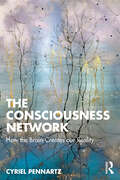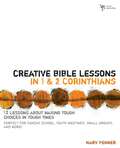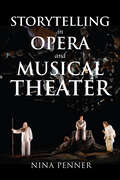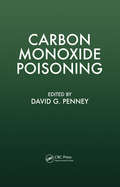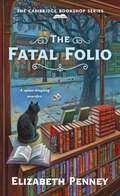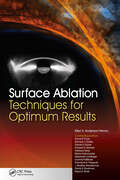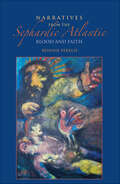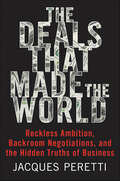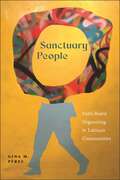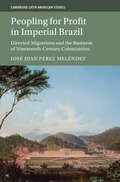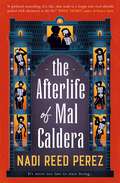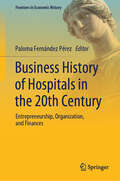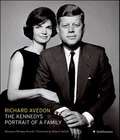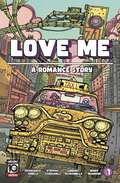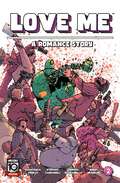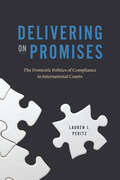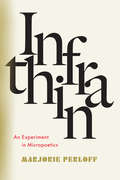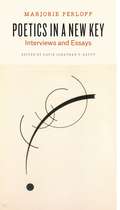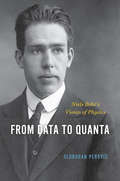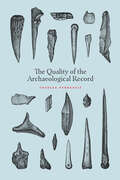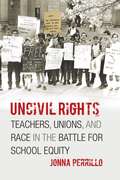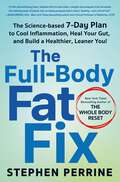- Table View
- List View
The Consciousness Network: How the Brain Creates our Reality
by Cyriel PennartzWhat is the relationship between consciousness and our brain? Are they one and the same? Who are we really? The Consciousness Network presents a novel account of one of the greatest scientific challenges of the twenty-first century: understanding the connection between brain and mind.The book explores remarkable cases of patients who demonstrate how our impression of reality is created by the brain. Age-old questions about dreams, colour perception, phantom sensations and hallucinations are illuminated by surprising discoveries from the latest brain research. How does consciousness differ from memory, emotions and behaviour? How did it develop during the evolution of life on earth, and does it serve a purpose? Does the brain leave room for free will? In this unique blend of philosophy, history, psychology and neuroscience, Cyriel Pennartz breaks new ground by presenting an original theory of brain and mind, substantiated by brain research in patients and healthy people. This theory, inspired by the seventeenth-century philosopher Spinoza, goes significantly deeper than current thinking based on computer models or artificial intelligence.The Consciousness Network is essential reading for students working at the interface of neuroscience, cognitive psychology, philosophy of mind and cognitive science, as well as anyone interested in consciousness and the brain.
Creative Bible Lessons in 1 and 2 Corinthians: 12 Lessons About Making Tough Choices in Tough Times (Creative Bible Lessons)
by Marv PennerChristian adolescents in the 21st century face pretty much the same situations as the first-century Christians in Corinth did -- an indulgent, profligate, choose-your-own-god society. The latest in the Creative Bible Lessons series, Creative Bible Lessons in 1 & 2 Corinthians is a 12-lesson curriculum with an issues-oriented spin on living one’s faith in the real world. It lets teenagers wrestle with the tension between biblical instruction and cultural realities. These 12 studies about the not-so-easily-tamed people of Corinth and their founding pastor Paul of Tarsus pave the way for youth workers and Sunday school teachers to teach high schoolers about conversion, transformation, failure, leadership, authority, and God's constant saving love even in the midst of people making a mess of things. Here are some of the not-so-ancient issues you'll explore in this study: Give Me Liberty or Give Me Love, Friends Don't Let Friends Go Unforgiven, Those Pesky STDs (Sexually Tough Decisions), Love Is . . ., No Easy Answers, Show Me the Money, and Ouch! Of course, there's lots of what the Creative bible Lessons series is known for: provocative and relevant discussion starters, to-the-point scripts, high-energy games, reproducible pages of interactive activities -- all in the context of hard-core Bible study.12 lessons.
Storytelling in Opera and Musical Theater (Musical Meaning and Interpretation)
by Nina PennerStorytelling in Opera and Musical Theater is the first systematic exploration of how sung forms of drama tell stories. Through examples from opera's origins to contemporary musicals, Nina Penner examines the roles of character-narrators and how they differ from those in literary and cinematic works, how music can orient spectators to characters' points of view, how being privy to characters' inner thoughts and feelings may evoke feelings of sympathy or empathy, and how performers' choices affect not only who is telling the story but what story is being told. Unique about Penner's approach is her engagement with current work in analytic philosophy. Her study reveals not only the resources this philosophical tradition can bring to musicology but those which musicology can bring to philosophy, challenging and refining accounts of narrative, point of view, and the work-performance relationship within both disciplines. She also considers practical problems singers and directors confront on a daily basis, such as what to do about Wagner's Jewish caricatures and the racism of Orientalist operas. More generally, Penner reflects on how centuries-old works remain meaningful to contemporary audiences and have the power to attract new, more diverse audiences to opera and musical theater. By exploring how practitioners past and present have addressed these issues, Storytelling in Opera and Musical Theater offers suggestions for how opera and musical theater can continue to entertain and enrich the lives of 21st-century audiences.
Carbon Monoxide Poisoning
by David G. PenneyWhile an ever-present and familiar toxin, carbon monoxide (CO) remains the number one poison in our environment. This silent killer is responsible for over 2,000 deaths a year in the United States alone. The public and healthcare communities need quality information about the many risks presented by carbon monoxide exposure. Edited by a leading e
The Fatal Folio: The Cambridge Bookshop Series (The Cambridge Bookshop Series #3)
by Elizabeth PenneyIn the third in Elizabeth Penney's delightful Cambridge Bookshop series, The Fatal Folio, Molly Kimball is learning that every killer has a story…After moving to Cambridge, England, Molly Kimball has found a lot to love, including—of course—her family’s ancestral bookshop, Thomas Marlowe—Manuscripts and Folios. And though she’s not quite ready to use the “L” word when it comes to her boyfriend Kieran, she’s definitely fallen for his intimidating family’s library. His family is paying her handsomely for an updated catalog when Molly discovers the original manuscript of a Gothic novel, A Fatal Folio by the pseudonymous Selwyn Scott. Kieran’s cousin Oliver, a professor specializing in Gothic literature, is eager to publish a paper on the mystery—especially because a troublesome student, Thad, is threatening to file a complaint against him and prevent his long-awaited promotion. On Guy Fawkes Night, Molly, Kieran, and her friends set out to enjoy the costumes, fireworks, and fun—at least until a stray firework starts a panic, and the group stumbles upon a prone body, their face covered by a mask. It’s Thad, and he’s been stabbed to death. It soon becomes clear Oliver isn’t the only one with a motive, and Molly must once again put on a few masks of her own to sleuth out Thad’s killer, prove Oliver’s innocence, and discover what Selwyn’s novel might have to do with this most atmospheric mystery…
Surface Ablation: Techniques for Optimum Results
by Ellen PennoWith Surface Ablation: Techniques for Optimum Results, refractive surgeons will learn efficient pre- and post-op routines that optimize chair time and lead to improved safety and excellent results for patients. Inside Surface Ablation: Techniques for Optimum Results by Dr. Ellen Anderson Penno is joined by 9 contributors who offer a practical approach with clinically useful tips including patient counseling and post-operative care that will improve patient satisfaction. This up-to-date book is an excellent resource for patient assessment of candidacy for refractive surgery or in post-operative co-management. In addition to chapters with information on patient selection, surgical techniques, post-op care, and prevention and management of complications, Surface Ablation: Techniques for Optimum Results includes several articles, contributed by leaders in the refractive surgery field, covering a variety of topics including surface ablation in keratoconus patients, corneal cross-linking, and ectasia. Surface Ablation: Techniques for Optimum Results is a clinically-oriented resource for residents and new refractive surgeons as well as the many seasoned refractive surgeons, general ophthalmologists following the increasing trend of transitioning away from LASIK towards surface ablation for many of their patients.
Synthesis of Pyrrol-based Bioconjugates: Perspectives and Applications
by Mariette M. Pereira Sara M.A. Pinto Lucas D. DiasIn recent years, the use of bioconjugation as strategy for development of more specific and directed drugs has been widely researched. Tetrapyrrolic macrocycles are one of the most common families of organic compounds applied in medicinal chemistry, specifically for diagnosis and therapy. For optimization of their efficiency as therapeutic molecules, it is relevant to promote their linking to biomolecules capable of targeting altered cells. This work brings a new dimension to the literature by combining structural modification of biomolecules and polymers with pyrrole-based compounds. It will be of great interest to academicians, industrialists, and undergraduate and graduate students of chemistry, biosciences, and pharmacy since, as apart from the theoretical aspects, it discusses experimental components.Features: Discusses methods for protein modification. Useful for academicians, industrialists and undergraduate and graduated students of chemistry, biosciences, and pharmacy. Explains the synthesis of pyrrole-based molecules.
Narratives from the Sephardic Atlantic: Blood and Faith (Sephardi and Mizrahi Studies)
by Ronnie PerelisIdentity, family, and community unite three autobiographical texts by New World crypto-Jews, or descendants of Jews who were forced to convert to Christianity in 17th-century Iberia and Spanish America. Ronnie Perelis presents the fascinating stories of three men who were caught within the matrix of inquisitorial persecution, expanding global trade, and the network of crypto-Jewish activity. Each text, reflects the unique experiences of the author and illuminates their shared, deeply rooted attachment to Iberian culture, their Atlantic peregrinations, and their hunger for spiritual enlightenment. Through these writings, Perelis focuses on the social history of transatlantic travel, the economies of trade that linked Europe to the Americas, and the physical and spiritual journeys that injected broader religious and cultural concerns into this complex historical moment.
The Deals that Made the World: Reckless Ambition, Backroom Negotiations, and the Hidden Truths of Business
by Jacques Peretti"Excellent. ... Impressive." —Financial TimesAn award-winning investigative journalist takes us inside the ten business deals that have transformed the modern worldWe tend to think of our world as controlled by forces we basically understand, primarily the politicians we elect. But in The Deals That Made the World, Jacques Peretti makes a provocative and quite different argument: much of the world around us—from the food we eat to teh products we buy to the medications we take—is shaped by private negotiations and business deals few of us know about.The Deals That Made the World takes us inside the sphere of these powerful players, examining ten groundbreaking business deals that have transformed our modern economy. Peretti reveals how corporate executives engineered an entire diet industry built on failure; how PayPal conquered online payments (and the specific behavioral science that underpins its success); and how pharmaceutical executives concocted a plan to successfully market medications to healthy people.For twenty years, Peretti has interviewed the people behind the decisions that have altered our world, from the CEOs of multinational corporations to politicians, economists, and scientists. Drawing on his vast knowledge, Peretti reveals a host of fascinating and startling connections, from how Wall Street's actions on food commodities helped spark the Arab Spring to the link between the AIDS epidemic in 1980s San Francisco and the subprime mortgage crisis of 2008. Touching upon tech, finance, artificial intelligence, and the other levers of power in a postglobalization environment, Peretti offers a compelling way to understand the last hundred years—and a suggestion of what the next hundred might hold.An essential book for anyone seeking to understand the hidden forces that shape our modern economy, The Deals That Made the World is illuminating and surprising—and an immensely fun read.
Diversity's Child: People of Color and the Politics of Identity
by Efrén O. PérezAn incisive look at how America’s continued demographic explosion has spurred the development of a new identity as people of color. For decades now, pundits and political scientists have been pointing to a major demographic change that’s underway in the United States. Demographers project that whites will become a minority of the US population and that minority groups will jointly comprise a majority before 2050. Diversity’s Child appraises the political ramifications of this change. Efrén O. Pérez deftly argues that America’s changing demographics are forging a new identity for many as people of color—that unifies the political outlook of assorted minority groups. Drawing on opinion surveys of multiple minority groups, social science experiments with minority adults, content analyses of newspapers and congressional archives, and in-depth interviews with minority individuals, Pérez makes two key points. First, a person of color's identity does exist, and we can reliably measure it, as well as distinguish it from other identities that minorities hold. Second, across a wide swath of circumstances, identifying as a person of color profoundly shapes how minorities view themselves and their political system. Diversity’s Child is a vital and engaging look at America’s identity politics as well as at how people of color think about racial disparities and how politics can best solve them.
Sanctuary People: Faith-Based Organizing in Latina/o Communities
by Gina M. PérezExplores ways faith communities offer protection and services for Latina/o communitiesThe New Sanctuary Movement is a network of faith-based organizations committed to offering safe haven to those in danger, often in churches, often outside the law, and often at risk to themselves. The practice of sanctuary, with its capacity to provide safety, shelter, and protection to society's most vulnerable, gained significant prominence after the 2016 presidential election and the ushering in of particularly harsh anti-immigration policies.Since 2017, Ohio has had some of the highest numbers of public sanctuary cases in the nation. Sanctuary People explores these sanctuary practices in Ohio and locates them in broader local and national efforts to provide refuge and care in the face of the challenges facing Latina/o communities in a moment of increased surveillance, migrant detention, displacement, and economic and social marginalization. Pérez argues for a conceptualization of sanctuary that is capacious, placing support of Puerto Ricans displaced in the wake of Hurricane Maria within the broader practices of sanctuary and expanding our understandings of the movement that addresses the precarious conditions of Latinas/os beyond migration status.Based on four years of ethnographic research and interviews at the local, state, and national levels, Sanctuary People offers a compelling exploration of the ways in which faith communities are creating new activist strategies and enacting new forms of solidarity, working within the sometimes conflicting ideological space between religion and activism to answer the call of justice and live their faith.
Peopling for Profit in Imperial Brazil: Directed Migrations and the Business of Nineteenth-Century Colonization (Cambridge Latin American Studies)
by null José Juan Pérez MeléndezPeopling for Profit provides a comprehensive history of migration to nineteenth-century imperial Brazil. Rather than focus on Brazilian slavery or the mass immigration of the end of the century, José Juan Pérez Meléndez examines the orchestrated efforts of migrant recruitment, transport to, and settlement in post-independence Brazil. The book explores Brazil's connections to global colonization drives and migratory movements, unveiling how the Brazilian Empire's engagement with privately run colonization models from overseas crucially informed the domestic sphere. It further reveals that the rise of a for-profit colonization model indelibly shaped Brazilian peopling processes and governance by creating a feedback loop between migration management and government formation. Pérez Meléndez sheds new light on how directed migrations and the business of colonization shaped Brazilian demography as well as enduring social, racial, and class inequalities. This title is part of the Flip it Open programme and may also be available Open Access. Check our website Cambridge Core for details.
The Afterlife of Mal Caldera
by Nadi Reed PerezMal's life is over. Her afterlife is only just beginning...By turns irreverently funny and deeply moving, this debut contemporary fantasy is perfect for fans of They Both Die at the End and The Invisible Life of Addie LaRue.Mal Caldera—former rockstar, retired wild-child and excommunicated black sheep of her Catholic family—is dead. Not that she cares. She only feels bad that her younger sister, Cris, has been left to pick up the pieces Mal left behind. While her fellow ghosts party their afterlives away at an abandoned mansion they call the Haunt, Mal is determined to make contact with Cris from beyond the grave. She enlists the help of a reluctant local medium, Ren, and together, they concoct a plan to pass on a message to Cris. But the more time they spend together, the more they begin to wonder what might have been if they'd met before Mal died.Mal knows it&’s wrong to hold on so tightly to her old life. Bad things happen to ghosts who interfere with the living, and Mal can't help wondering if she&’s hurting the people she loves by hanging around, haunting their lives. But Mal has always been selfish, and letting go might just be the hardest thing she's ever had to do. Funny, emotional and life-affirming, The Afterlife of Mal Caldera will have readers laughing one minute and sobbing the next.
Business History of Hospitals in the 20th Century: Entrepreneurship, Organization, and Finances (Frontiers in Economic History)
by Paloma Fernández PérezThis book offers a business history of modern hospitals in the 20th century. Presenting case studies from around the world, it examines the long-term institutional and historical evolution of hospital organization and management models, applying a business history approach to do so. Drawing on reports from international organizations and other historical data, it explores the evolution, path dependencies, actors and institutions that have shaped the diversity of hospital organization and management models. At the same time, it analyzes the historical origins of major problems faced by today’s hospitals, such as cost-inefficiencies, lack of specialized human capital, etc. The contributing authors cover topics such as the history of hospital finance and accounting, hospital price regulation, entrepreneurship models, hospital privatization, and hospital governance. The book will appeal to scholars and students of economic and business history, and to anyone interested in the history of hospitals.
The Kennedys: Portrait of a Family
by Shannon Thomas Perich Richard AvedonIn the early 1960s, Richard Avedon was commissioned by Harper's Bazaar to create Observations, a column that consisted of a series of nine photographic essays. The subject of the first essay was John F. Kennedy and his young family, who sat for formal black-and-white portraits just three weeks prior to Kennedy's presidential inauguration. Six images appeared in the magazine's February 1961 issue.That same day, Avedon created more informal color portraits of Kennedy and his family at the Kennedy compound in Palm Beach. One of these images ran as the cover of LOOK magazine's February 28 issue, with photographs by Avedon inside. Just before the magazine hit the newsstands and was delivered to over 6.5 million people, a set of photographs, comprised mostly of the LOOK images, was released by the White House and appeared in newspapers across the country.During his lifetime, Richard Avedon donated more than two hundred images to the Smithsonian Institution, including all of the photographs of the Kennedy family sitting for Harper's Bazaar. Smithsonian curator Shannon Thomas Perich has culled more than seventy-five images from that donation for The Kennedys: Portrait of a Family, making these stunning photographs available for view for the first time. Perich's introductory essay—accompanied by a wealth of archival photographs of both Avedon and the Kennedy family—provides historical background on the two sittings within a political and cultural context and critically examines the work of one of the finest photographers of the twentieth century. A foreword by Robert Dallek, distinguished historian and author of the bet-selling An Unfinished Life: John F. Kennedy, 1917-1963, provides authoritative and compelling insight to one of the most fascinating presidents in American history.
Love Me: A Romance Story #1 (Love Me #1)
by Francesca PerilloNew York City, sometime in the far future, where robots like JoJo have taken over the tasks humans no longer want to perform…like driving a taxi. JoJo is pretty happy with his lot in life but feels as though something is missing…then he meets Gilda and it&’s love at first sight. But the course of true love is a bumpy one and JoJo is going to find that out firsthand when he discovers that Gilda is entangled with the mafia that runs his beloved city, and they&’re very much against this potential union for their own reasons. Watch out, JoJo!
Love Me: A Romance Story #2 (Love Me #2)
by Francesca PerilloIt was love at first sight…or at least it was for JoJo, but Gilda never showed up for their date. JoJo is a robot, but he does have feelings, and his heart has been broken. However, JoJo has received a call from a very distressed Gilda but their conversation was cut short…something horrible has happened to her, and JoJo has made it his mission to find her. Don&’t worry, Gilda, JoJo is on the case!
Delivering on Promises: The Domestic Politics of Compliance in International Courts (Chicago Series on International and Domestic Institutions)
by Lauren J. PeritzA timely investigation into the conditions that make international agreements—and the institutions that enforce them—vulnerable. When do international institutions effectively promote economic cooperation among countries and help them resolve conflict? Although the international system lacks any central governing authority, states have created rules, particularly around international economic relations, and empowered international tribunals to enforce those rules. Just how successful are these institutions? In Delivering on Promises Lauren J. Peritz demonstrates that these international courts do indeed deliver results—but they are only effective under certain conditions. As Peritz shows, states are less likely to comply with international rules and international court decisions when domestic industries have the political ability to obstruct compliance in particular cases. The author evaluates the argument with an extensive empirical analysis that traces the domestic politics of compliance with the decisions of two international economic courts: the World Trade Organization’s dispute settlement mechanism and the Court of Justice of the European Union. At a time when international agreements are under attack, this book sheds light on the complex relationship between domestic politics and international economic cooperation, offering detailed evidence that international economic courts are effective at promoting interstate cooperation.
Heaven and Earth Are Not Humane: The Problem of Evil in Classical Chinese Philosophy (World Philosophies)
by Franklin PerkinsThat bad things happen to good people was as true in early China as it is today. Franklin Perkins uses this observation as the thread by which to trace the effort by Chinese thinkers of the Warring States Period (c.475-221 BCE), a time of great conflict and division, to seek reconciliation between humankind and the world. Perkins provides rich new readings of classical Chinese texts and reflects on their significance for Western philosophical discourse.
Infrathin: An Experiment in Micropoetics
by Marjorie PerloffEsteemed literary critic Marjorie Perloff reconsiders the nature of the poetic, examining its visual, grammatical, and sound components. The “infrathin” was Marcel Duchamp’s playful name for the most minute shade of difference: that between the report of a gunshot and the appearance of the bullet hole, or between two objects in a series made from the same mold. “Eat” is not the same thing as “ate.” The poetic, Marjorie Perloff suggests, can best be understood as the language of infrathin. For in poetry, whether in verse or prose, words and phrases that are seemingly unrelated in ordinary discourse are realigned by means of sound, visual layout, etymology, grammar, and construction so as to “make it new.” In her revisionist “micropoetics,” Perloff draws primarily on major modernist poets from Stein and Yeats to Beckett, suggesting that the usual emphasis on what this or that poem is “about,” does not do justice to its infrathin possibilities. From Goethe’s eight-line “Wanderer’s Night Song” to Eliot’s Four Quartets, to the minimalist lyric of Rae Armantrout, Infrathin is designed to challenge our current habits of reading and to answer the central question: what is it that makes poetry poetry?
Poetics in a New Key: Interviews and Essays
by Marjorie PerloffMarjorie Perloff writes in her preface to Poetics in a New Key that when she learned David Jonathan Y. Bayot wanted to publish a collection of her interviews and essays, she was “at once honored and mystified.” But to Perloff’s surprise and her readers’ delight, the resulting assembly not only presents an accessible and provocative introduction to Perloff’s critical thought, but also highlights the wide range of her interests, and the energetic reassessments and new takes that have marked her academic career. The fourteen interviews in Poetics in a New Key—conducted by scholars, poets, and critics from the United States, Denmark, Norway, France, and Poland, including Charles Bernstein, Hélène Aji, and Peter Nicholls—cover a broad spectrum of topics in the study of poetry: its nature as a literary genre, its current state, and its relationship to art, politics, language, theory, and technology. Also featured in the collection are three pieces by Perloff herself: an academic memoir, an exploration of poetry pedagogy, and an essay on twenty-first-century intellectuals. But across all the interviews and essays, Perloff’s distinctive personality and approach to reading and talking resound, making this new collection an inspiring resource for scholars both of poetry and writing.
From Data to Quanta: Niels Bohr’s Vision of Physics
by Slobodan PerovicThe first comprehensive philosophical and historical account of the experimental foundations of Niels Bohr’s practice of physics. Niels Bohr was a central figure in quantum physics, well known for his work on atomic structure and his contributions to the Copenhagen interpretation of quantum mechanics. In this book, philosopher of science Slobodan Perovic explores the way Bohr practiced and understood physics, and analyzes its implications for our understanding of modern science. Perovic develops a novel approach to Bohr’s understanding of physics and his method of inquiry, presenting an exploratory symbiosis of historical and philosophical analysis that uncovers the key aspects of Bohr’s philosophical vision of physics within a given historical context. To better understand the methods that produced Bohr’s breakthrough results in quantum phenomena, Perovic clarifies the nature of Bohr’s engagement with the experimental side of physics and lays out the basic distinctions and concepts that characterize his approach. Rich and insightful, Perovic’s take on the early history of quantum mechanics and its methodological ramifications sheds vital new light on one of the key figures of modern physics.
The Quality of the Archaeological Record
by Charles PerreaultPaleobiology struggled for decades to influence our understanding of evolution and the history of life because it was stymied by a focus on microevolution and an incredibly patchy fossil record. But in the 1970s, the field took a radical turn, as paleobiologists began to investigate processes that could only be recognized in the fossil record across larger scales of time and space. That turn led to a new wave of macroevolutionary investigations, novel insights into the evolution of species, and a growing prominence for the field among the biological sciences. In The Quality of the Archaeological Record, Charles Perreault shows that archaeology not only faces a parallel problem, but may also find a model in the rise of paleobiology for a shift in the science and theory of the field. To get there, he proposes a more macroscale approach to making sense of the archaeological record, an approach that reveals patterns and processes not visible within the span of a human lifetime, but rather across an observation window thousands of years long and thousands of kilometers wide. Just as with the fossil record, the archaeological record has the scope necessary to detect macroscale cultural phenomena because it can provide samples that are large enough to cancel out the noise generated by micro-scale events. By recalibrating their research to the quality of the archaeological record and developing a true macroarchaeology program, Perreault argues, archaeologists can finally unleash the full contributive value of their discipline.
Uncivil Rights: Teachers, Unions, and Race in the Battle for School Equity
by Jonna PerrilloAlmost fifty years after Brown v. Board of Education, a wealth of research shows that minority students continue to receive an unequal education. At the heart of this inequality is a complex and often conflicted relationship between teachers and civil rights activists, examined fully for the first time in Jonna Perrillo’s Uncivil Rights, which traces the tensions between the two groups in New York City from the Great Depression to the present.While movements for teachers’ rights and civil rights were not always in conflict, Perrillo uncovers the ways they have become so, brought about both by teachers who have come to see civil rights efforts as detracting from or competing with their own goals and by civil rights activists whose aims have de-professionalized the role of the educator. Focusing in particular on unionized teachers, Perrillo finds a new vantage point from which to examine the relationship between school and community, showing how in this struggle, educators, activists, and especially our students have lost out.
The Full-Body Fat Fix: The Science-Based 7-Day Plan to Cool Inflammation, Heal Your Gut, and Build a Healthier, Leaner You!
by Stephen PerrineDiscover a groundbreaking new way of eating that can reverse inflammation, heal your gut, and improve your overall health, fitness and athletic performance—in just one week—while setting you on the path to easy, sustainable weight loss for life!Journalist and bestselling author Stephen Perrine reveals how in his intensely researched, yet simple and engaging new book, The Full-Body Fat Fix. With a unique blend of humor and science, Perrine explains how chronic inflammation and an unhealthy microbiome are the underlying causes of weight gain, and how classic “dieting” strategies—like cutting calories, eliminating certain foods or only eating during specific times—actually undermine our weight-loss goals. The new science of weight management is more exciting and delicious than we ever imagined. Simply by eating a greater variety of plant-based foods—at least 30 different plants each week, including vegetables, fruits, whole grains, seeds, nuts, herbs and legumes—and not getting stuck with the same old “healthy” foods again and again, science shows we can bring healing back to our guts, turn off the mechanisms that cause inflammation and reduce our risk of obesity and its related diseases. In Perrine’s hands, this trick is as easy as it is delicious, starting with “The Fire Fightin’ Five,” a yummy combination of five meals and snacks (including pizza!) that will give you 30 unique plants—effortlessly! And with his 7-Day Challenge, you’ll be able to track and maximize your dietary goals—and make a game out of healthy eating and weight loss. (How many different plants can you eat? Can you squeeze in more than your friends and family?) To make it even easier, dozens of recipes populate the book, each one as enticing as the next.Weight loss has never been as fun, as delicious, or as easy to enjoy.
